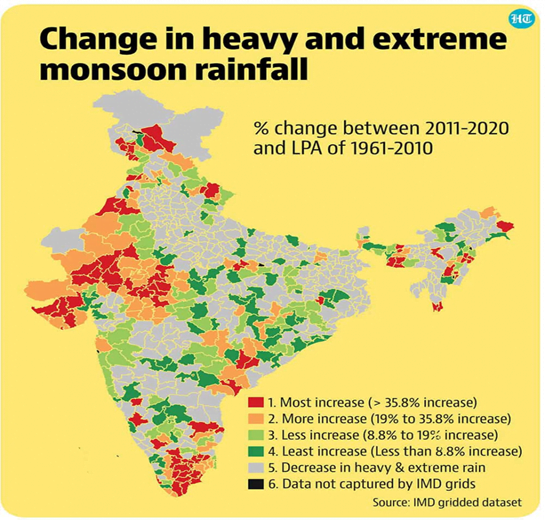Geography
Context: Recently, over 20 people have been killed in destruction caused by cloudbursts and flash floods in different parts of Himachal Pradesh and Uttarakhand over the last three day.
- As heavy rainfall was observed in these states during the short duration of time which leads to the heavy rainfall triggering landslides and flash floods that have disrupted rail and road traffic, and resulted in house and wall collapses.
What are cloudbursts?
- A cloudburst is a localized but intense rainfall activity.
- According to the India Meteorological Department (IMD) a cloudburst features very heavy rainfall over a localized area at a very high rate of the order of 10 cm per hour featuring strong winds and lightning over a geographical region of approximately 20 to 30 Sq. Kms.
- By this definition, 5 cm of rainfall in a half-hour period over the same area would also be categorized as a cloudburst.
How common are cloudbursts?
- Cloudbursts are not uncommon events, particularly during the monsoon months.
- Most of these happen in the Himalayan states where the local topology, wind systems, and temperature gradients between the lower and upper atmosphere facilitate the occurrence of such events.
- However, not every event that is described as a cloudburst is actually, by definition, a cloudburst. That is because these events are highly localized.
- Because of the nature of terrain, the heavy rainfall events often trigger landslides and flash floods, causing extensive destruction downstream.
- This is the reason why every sudden downpour that leads to destruction of life and property in the hilly areas gets described as a “cloudburst”, irrespective of whether the amount of rainfall meets the defining.
Is it possible to forecast cloudburst?
- The India Meteorological Department forecasts rainfall events well in advance, but it does not predict the quantum of rainfall — in fact, no meteorological agency does.
- The forecasts are for a relatively large geographical area, usually a region, a state, a meteorological sub-division, or at best a district. As they zoom in over smaller areas, the forecasts get more and more uncertain.)
- Therefore, specific cloudburst events cannot be forecast.
- No forecast ever mentions a possibility of a cloudburst. But there are warnings for heavy to very heavy rainfall events, and these are routinely forecast four to five days in advance.
As per the IMD, there is no long-term trend that suggests that cloudbursts are rising. However, the incidents of extreme rainfall, as also other extreme weather events, are increasing, not just in India but across the world.
Several studies have shown that climate change will increase the frequency and intensity of cloudbursts in many cities across the globe.
- In May, the World Meteorological Organization noted that there is about a 40% chance of the annual average global temperature temporarily reaching 1.5°C above the pre-industrial level in at least one of the next five years.

Source: Indian Express












